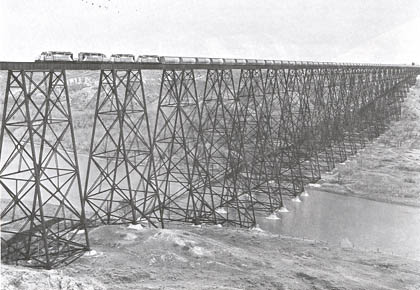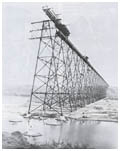
Public Relations and Advertising
Department
Windsor Station Montreal Que. H3C 3E4
|
Volume
7 Number 13
|
Oct. 12,
1977
|
High Level Bridge Still Record
Holder
By
Shirley Whittet

One of the Wonders of the world:
That's what one newspaper called the high level bridge at Lethbridge when it was
opened to traffic in 1909. This structure is so well built that it can carry the
heaviest of today's traffic, such as this seemingly endless grain
train.
The marvel of engineering located
3,800 feet west of Lethbridge, Alberta, has been known by a variety of names. Some
called it "The Big Bridge", others knew it as the "High Level
Bridge". To it's designers it was known either as the "CPR Viaduct" or
the "Lethbridge Viaduct".
"The Belly River Bridge" was often seen on plans though official company
records call it "Viaduct 1.1 Crowsnest Subdivision". However, the CP Rail
High Level Bridge seems to be the currently accepted name.
Whatever its name, this famous landmark, completed in 1909, is still the highest and
longest structure of its kind in the world. 5,328.6 feet long with a maximum height
of 313.7 feet it can still accommodate today's massive loads with ease.
Blackfoot
| |

Traveller at Work: The
high level bridge at Lethbridge with construction at about the
half-way mark. Photo shows the steel erection traveller with
workers' cage suspended from its boom. Some distance behind it is the wooden
riveting traveller holding cages as riveters work on the towers. Immensity of
the structure can be compared with the human figure standing on pedestal in
foreground.
|
Built at a cost of $1,334,525 the viaduct spans a wide valley through which flows the
Oldman River ( formerly the Belly River ) named after a Blackfoot deity. The new rail
line and bridge reduced distance and travelling time between Lethbridge and Macleod (
now Fort Macleod ) in Alberta.
Before its construction, westbound trains from Lethbridge ran a circuitous route
along the Oldman River to a point about five miles upstream, where a crossing was
made. From there, the rail line climbed a steep grade, crossed 24 bridges and
navigated curves equal to five circles.
The new route, with the viaduct, shortened the trip by more than five miles, reduced
the number of bridges to two and lopped one hour off the time schedule.
Contract for the new bridge was let in 1906 to the Canadian Bridge Company of
Walkerville, Ontario, for steelwork and to John Gunn and Sons of Winnipeg for the
substructure. Work began in 1907 but was delayed n 1908 by floods. However, steel
work started in August, 1908, and the bridge was completed by June, 1909.
It took 646 railway flat cars to transport the 12,436 tons of steel to the
construction site, and another 225 cars to carry the other building materials.
The viaduct is made up of 44 plate girder spans 67 feet 1 inch in length,
twenty-two 98 feet 10 inch plate girder spans, a 167 foot riveted deck
lattice truss span and 33 riveted steel towers, of varying heights, rigidly braced.
It rests on concrete piles supporting concrete pedestals. Piles under the land piers
vary in depth from 12 to 20 feet.
Column footings had to be adequately anchored to piers because of the uplift from
high winds. Anchor bolts 1 1/2 inches in diameter and nearly nine feet long were used
in such a way that one corner of a tower was fixed, while the other three were free
to move with expansion or contraction of the steel. Allowance for movement was
provided by a system of sliding plates, permanently lubricated with graphite.
Because of the bridge's unusual height and frequency of severe winds, through spans
were used instead of the deckplate girder type. The track was nestled between two
eight foot high girder spans instead of running on top of them - making it practically
impossible for derailed cars to fall over.
These same high winds also played havoc with preliminary work and measuring
operations. An unsupported steel measuring tape couldn't be used, so a new device was
made on the spot from a well seasoned 16 foot long cedar 2 x 4 with brass plates
attached. This resulted in a highly accurate 15 foot measuring rod. Even the plumb
bobs had to be protected by wind shields.
To build the mammoth steel structure, a special erection traveller had to be made at
a cost of $100,000 - a lot of money by 1908 standards. It was made entirely of steel,
except for flooring and engine house. The whole thing stood 60 feet high, took a
month to build and weighed 712,000 pounds. Eleven miles of cable were used for
lowering and raising the column material.
For safety, the men worked from two assembling cages which were put into place by 85
foot booms and temporarily bolted to the steel columns.
A smaller riveting traveller was also used from which cages were suspended from an
overhang to expedite riveting jobs.
When the job was completed, the structure was given two coats of paint - 7,600 gallons
of it.
The bridge was so well constructed that it was 49 years before any major repairs were
needed. The biggest repair job was in 1958 when a periodic check of levels showed that
three of the north piers of adjoining bents ( or towers ) near the west end had sunk
from one to two inches - apparently caused by seepage from irrigated land.
Floodwaters
A powerful jack was used to lift a portion of the side of the bridge allowing iron
shim plats, about two feet square, to be placed between the cement pier and the
bottom of the steel column. That same year, according to Andrew J. Staysko, retired
locomotive engineer, flood waters undermined one of the piers. This was
re-cemented and a section of retaining wall was put in for a distance
upstream from it.
As part of the regular track patrol, a visual inspection is made of the bridge three
times a week. B&B crews also carry out their own inspections. These used to be
fairly frequent walking assignments, but now it's speeded up considerably and made
safer by construction in 1966 of a trackside walkway.
Besides the Oldman River, a lot of history has passed under, as well as over, the
bridge.
Gunpowder Plot
During World War I, 23 kegs of blasting powder were found stashed under the bridge.
Because of this, and because the viaduct was considered a vital link in
communications - it was kept under constant guard for the duration of the war.
When the great depression of the 30's came along, a hobo jungle was established under
the first span. These hoboes were ordinary Canadian men and women who were forced
from their homes by unemployment. They travelled as best they could by freight train
in search of work.
An inscription plaque is attached to a stone marker at the east end of the bridge
giving its vital statistics; a song has been written about it - "The Mighty
Bridge", but unfortunately it never made the hit parade.
This CP Rail News article is
copyright 1977 by Canadian Pacific Railway and is reprinted here with their
permission. All photographs, logos, and trademarks are the property of the Canadian
Pacific Railway Company.
©
2005 William C. Slim
http://www.okthepk.ca
|